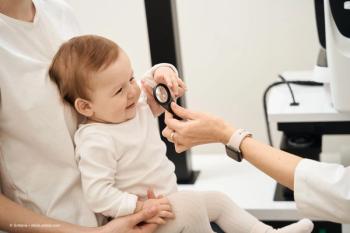
SOE 2023: New dehydrated human amniotic membrane promotes healing of the ocular surface
Omnigen® may be an alternative treatment option for patients with a persistent corneal epithelial defect. The product provides a convenient and effective treatment that can be administered in an outpatient setting.
Approved by Derek H-K Ho, MA
Derek K-H Ho, MA (Cantab) FRCOphth, and colleagues reported the “largely favourable outcomes” achieved with use of a dehydrated human amniotic membrane to promote healing of the ocular surface. Ho, a cornea research fellow from the Corneal Service, Bristol Eye Hospital, Bristol, UK, presented his team’s 2.5-year experience at the European Society of Ophthalmology, Prague.
Omnigen® (NuVision® Biotherapies, UK) is processed using patented dehydration process using low-temperature vacuum evaporation allowing the tissue to be stored between 2-25ºC. It may be an alternative treatment option for patients with a persistent corneal epithelial defect, in that the product provides a convenient and effective treatment that can be administered in an outpatient setting. Omnigen is a commercially available product that is applied beneath a specialised bandage contact lens (OmniLenz®) in the same manner as a patient positions a contact lens on the eye.
A number of advantages are associated with the use of human amniotic membrane on the corneal surface in that the tissue reduces inflammation, scarring, and neovascularisation; promotes corneal re-epithelialisation; protects the ocular surface from further external insults; and provides tectonic support in an eye at risk of or with corneal perforation, he explained.
The researchers conducted a retrospective case review of all patients who received Omnigen implants from December 2019 to August 2022. The primary outcome measures were determining the resolution of the original disease or injury and the time to recovery. The secondary outcome measure was the final recorded best-corrected visual acuity (BCVA).
A total of 26 eyes of 25 patients (58% men; mean age, 57.7 years; range 21-89) was treated with Omnigen during the study period.
Results with Omnigen
By far, the most common pathology treated was persistent corneal epithelial defects in 81% of the eyes followed by 1 case each of corneal graft melt, surgically induced necrotising sclerokeratitis, a decompensating cornea from chemical injury, following repair of a global rupture, and scleral repair surgery after blebitis.
When all cases were considered, the time from onset of presentation to Omnigen use was 55 ± 64.7 days, the duration of follow-up was 213.7 ± 183.5 days, and successful outcomes were achieved in 20 (77%) of 26 eyes.
When a subgroup of cases with a persistent corneal epithelial defect were considered alone, the results were similar. The time from onset of presentation to Omnigen use was 59 ± 68.7 days, the duration of follow-up was 247.4 ± 193.5 days, and successful outcomes were achieved in 16 (76%) of eyes. The mean time to healing of the corneal defect was 45.0 ± 41.9 days, and the patients achieved a final logarithm of the minimum angle of resolution BCVA of 1.07 ± 0.58.
Although not reaching statistical significance, a subgroup analysis of the patients with a persistent defect showed that in 9 eyes with neurotrophic ulcers compared with non-neurotrophic ulcers the patients were slightly older (59.3 years vs 56.7 years), had a concurrent infection (56% vs 25%), had a lower healing rate (75% vs 91%), and had a longer time to healing (56 days vs 39 days).
The study reached the following conclusions.
- The results demonstrated largely favourable outcomes from Omnigen use.
- Omnigen presents an alternative treatment option for patients with persistent corneal epithelial defects and provides a convenient and effective treatment that can be administered in an outpatient setting.
- The subgroup performance was interesting; however, the results did not reach significance.
Ho reported that a prospective study to examine the healing rate of persistent corneal epithelial defects (in mm²/day) after Omnigen use is underway.
Newsletter
Keep your retina practice on the forefront—subscribe for expert analysis and emerging trends in retinal disease management.















































